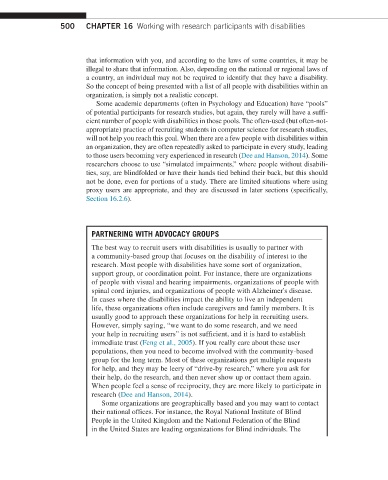Page 507 -
P. 507
500 CHAPTER 16 Working with research participants with disabilities
that information with you, and according to the laws of some countries, it may be
illegal to share that information. Also, depending on the national or regional laws of
a country, an individual may not be required to identify that they have a disability.
So the concept of being presented with a list of all people with disabilities within an
organization, is simply not a realistic concept.
Some academic departments (often in Psychology and Education) have “pools”
of potential participants for research studies, but again, they rarely will have a suffi-
cient number of people with disabilities in those pools. The often-used (but often-not-
appropriate) practice of recruiting students in computer science for research studies,
will not help you reach this goal. When there are a few people with disabilities within
an organization, they are often repeatedly asked to participate in every study, leading
to those users becoming very experienced in research (Dee and Hanson, 2014). Some
researchers choose to use “simulated impairments,” where people without disabili-
ties, say, are blindfolded or have their hands tied behind their back, but this should
not be done, even for portions of a study. There are limited situations where using
proxy users are appropriate, and they are discussed in later sections (specifically,
Section 16.2.6).
PARTNERING WITH ADVOCACY GROUPS
The best way to recruit users with disabilities is usually to partner with
a community-based group that focuses on the disability of interest to the
research. Most people with disabilities have some sort of organization,
support group, or coordination point. For instance, there are organizations
of people with visual and hearing impairments, organizations of people with
spinal cord injuries, and organizations of people with Alzheimer's disease.
In cases where the disabilities impact the ability to live an independent
life, these organizations often include caregivers and family members. It is
usually good to approach these organizations for help in recruiting users.
However, simply saying, “we want to do some research, and we need
your help in recruiting users” is not sufficient, and it is hard to establish
immediate trust (Feng et al., 2005). If you really care about these user
populations, then you need to become involved with the community-based
group for the long term. Most of these organizations get multiple requests
for help, and they may be leery of “drive-by research,” where you ask for
their help, do the research, and then never show up or contact them again.
When people feel a sense of reciprocity, they are more likely to participate in
research (Dee and Hanson, 2014).
Some organizations are geographically based and you may want to contact
their national offices. For instance, the Royal National Institute of Blind
People in the United Kingdom and the National Federation of the Blind
in the United States are leading organizations for Blind individuals. The

